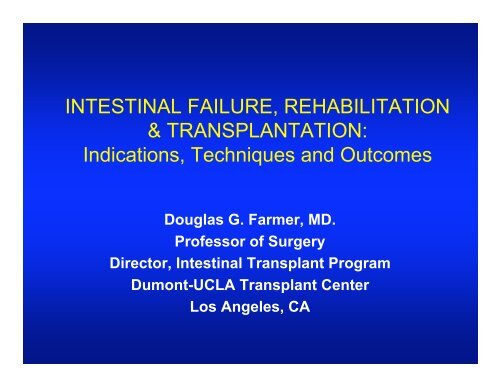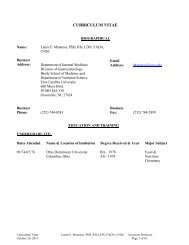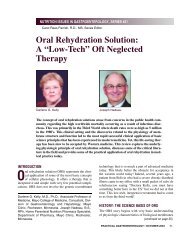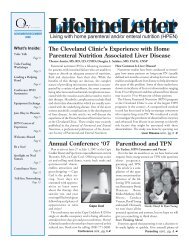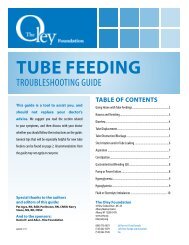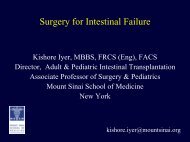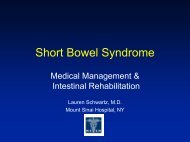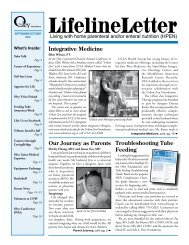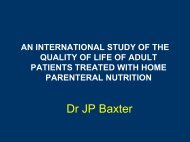Intestinal Failure, Rehabilitation and Transplant
Intestinal Failure, Rehabilitation and Transplant
Intestinal Failure, Rehabilitation and Transplant
You also want an ePaper? Increase the reach of your titles
YUMPU automatically turns print PDFs into web optimized ePapers that Google loves.
INTESTINAL FAILURE, REHABILITATION<br />
& TRANSPLANTATION:<br />
Indications, Techniques <strong>and</strong> Outcomes<br />
Douglas G. Farmer, MD.<br />
Professor of Surgery<br />
Director, <strong>Intestinal</strong> <strong>Transplant</strong> Program<br />
Dumont-UCLA <strong>Transplant</strong> Center<br />
Los Angeles, CA
Short Bowel/Gut Syndrome
Short Bowel/Gut Syndrome
DEFINITIONS<br />
<strong>Intestinal</strong> <strong>Failure</strong><br />
Condition resulting “from obstruction, dysmotility,<br />
surgical resection, congenital defect, or disease<br />
associated loss of absorption <strong>and</strong> is characterized by the<br />
inability to maintain protein-energy, fluid, electrolyte or<br />
micronutrient balance”.
<strong>Intestinal</strong> <strong>Failure</strong><br />
Functional Causes<br />
• Chronic <strong>Intestinal</strong> Pseudo-obstruction<br />
• Adhesions<br />
• Fistulae
<strong>Intestinal</strong> <strong>Failure</strong><br />
Mucosal Causes<br />
• Microvillous inclusion disease<br />
• Tufting enteropathy<br />
• Congenital neuroendocrinopathy
<strong>Intestinal</strong> <strong>Failure</strong><br />
Surgical Causes (ADULT)<br />
• IBD<br />
• Trauma<br />
• Volvulus<br />
• Mesenteric venous thrombosis<br />
• Mesenteric arterial thrombosis<br />
• Embolic phenomenon<br />
• XRT<br />
• Adhesions<br />
• Fistulae<br />
• Tumor (GIST, Desmoid; FAP)
<strong>Intestinal</strong> <strong>Failure</strong><br />
Surgical Causes (CHILDREN)<br />
• In utero volvulus<br />
• JI atresia<br />
• Gastroschisis<br />
• Omphalocele<br />
• Meconium ileus<br />
• Hirschsprungs<br />
Disease<br />
• NEC<br />
• Post-Natal volvulus<br />
• Pseudoobstruction
The Journey<br />
<strong>Intestinal</strong><br />
<strong>Failure</strong><br />
Enteral<br />
Autonomy
The Journey<br />
Parenteral<br />
Nutrition<br />
Support<br />
<strong>Intestinal</strong><br />
<strong>Failure</strong><br />
Enteral<br />
Autonomy
The Journey<br />
Parenteral<br />
Nutrition<br />
Support<br />
Enteral<br />
Feeding<br />
Regimen<br />
<strong>Intestinal</strong><br />
<strong>Failure</strong><br />
Enteral<br />
Autonomy
The Journey<br />
Parenteral<br />
Nutrition<br />
Support<br />
Enteral<br />
Feeding<br />
Regimen<br />
Medical<br />
Therapy<br />
Glutamine<br />
GH/GLP<br />
<strong>Intestinal</strong><br />
<strong>Failure</strong><br />
Enteral<br />
Autonomy
The Journey<br />
Parenteral<br />
Nutrition<br />
Support<br />
Enteral<br />
Feeding<br />
Regimen<br />
Medical<br />
Therapy<br />
Glutamine<br />
GH/GLP<br />
TPN<br />
Alterations<br />
(Lipids)<br />
<strong>Intestinal</strong><br />
<strong>Failure</strong><br />
Enteral<br />
Autonomy
The Journey<br />
Parenteral<br />
Nutrition<br />
Support<br />
Enteral<br />
Feeding<br />
Regimen<br />
Medical<br />
Therapy<br />
Glutamine<br />
GH/GLP<br />
TPN<br />
Alterations<br />
(Lipids)<br />
<strong>Intestinal</strong><br />
<strong>Failure</strong><br />
Enteral<br />
Autonomy<br />
Autologous<br />
Reconstructive<br />
Surgery
The Journey<br />
Parenteral<br />
Nutrition<br />
Support<br />
Enteral<br />
Feeding<br />
Regimen<br />
Medical<br />
Therapy<br />
Glutamine<br />
GH/GLP<br />
TPN<br />
Alterations<br />
(Lipids)<br />
<strong>Intestinal</strong><br />
<strong>Failure</strong><br />
Enteral<br />
Autonomy<br />
Autologous<br />
Reconstructive<br />
Surgery<br />
Fistula Management<br />
Stricture/adhesion Management<br />
Ostomy Management<br />
Lengthening Procedure (S.T.E.P)
The Journey<br />
Parenteral<br />
Nutrition<br />
Support<br />
Enteral<br />
Feeding<br />
Regimen<br />
Medical<br />
Therapy<br />
Glutamine<br />
GH/GLP<br />
TPN<br />
Alterations<br />
(Lipids)<br />
<strong>Intestinal</strong><br />
<strong>Failure</strong><br />
Enteral<br />
Autonomy<br />
Autologous<br />
Reconstructive<br />
Surgery<br />
<strong>Intestinal</strong><br />
<strong>Transplant</strong>ation<br />
Fistula Management<br />
Stricture/adhesion Management<br />
Ostomy Management<br />
Lengthening Procedure (S.T.E.P)
Parenteral Nutrition Support
OUTCOME PREDICTORS<br />
SURVIVAL<br />
• SMALL BOWEL<br />
LENGTH<br />
• ILEOCECAL VALVE<br />
• COLONIC RESECTION<br />
• ENTEROSTOMA<br />
• PN COMPLICATIONS<br />
• PN LIVER DISEASE<br />
ADAPTATION<br />
• SMALL BOWEL<br />
LENGTH<br />
• ILEOCECAL VALVE<br />
• COLONIC RESECTION<br />
• ENTEROSTOMA<br />
• CHOLECYSTECTOMY<br />
• #INFECTIONS<br />
• TIME ON TPN
TPN Complications<br />
Catheter Sepsis<br />
Catheter Occlusion<br />
Vascular thrombosis<br />
Cholelithiasis<br />
Liver Disease<br />
Bone Disease<br />
Nephrolithiasis<br />
Renal Function<br />
Death
Survival on TPN<br />
Aliment Pharmacol Ther 2006
TPN Alterations to Minimize<br />
Complications
Minimization of TPN Complications<br />
• Optimize enteral feeding<br />
• Eliminate sepsis<br />
• Line care<br />
– Vanco <strong>and</strong> ampho Locks<br />
– Ethanol locks<br />
• Identify coagulation disorders<br />
• TPN formulation alterations
Fish Oil Emulsions<br />
Omegaven®
Prospective, Case Controlled Trial of 24<br />
weeks of Intravenous Fish Oil in Children with<br />
<strong>Intestinal</strong> <strong>Failure</strong> Associated Liver Disease<br />
Kara Calkins* 1 , Stephen Shew 2 , James<br />
Dunn 2 , Douglas Farmer 2 , <strong>and</strong> Robert<br />
Venick 1,2<br />
1<br />
Department of Pediatrics, 2 Department of Surgery<br />
University of California, Los Angeles<br />
*Supported by NIH grant T32GM75776‐6
PROSPECTIVE FO COHORT<br />
RETROSPECTIVE SO COHORT<br />
Satisfies Inclusion Criteria<br />
Satisfies Inclusion Criteria<br />
FO<br />
Omegaven 1 gm/kg/d IV<br />
X 24 weeks or until death/transplant<br />
SO<br />
Intralipid 0.5 – 4 gm/kg/d<br />
x 24 weeks or until<br />
death/transplant
BILIRUBIN<br />
Geometric Mean Total Bilirubin<br />
(mg/dL)<br />
16<br />
14<br />
12<br />
10<br />
8<br />
6<br />
4<br />
2<br />
0<br />
-2<br />
** **<br />
** **<br />
5 10 15 20 25<br />
Weeks<br />
FO<br />
SO<br />
**p-value
Medical Therapies for<br />
adaptation
Glutamine <strong>and</strong> Growth Hormone<br />
“In the last decade, most IF research has<br />
been focused on exploring the potential of<br />
these substances as supportive IF treatment.<br />
However, clinical trials so far have not<br />
demonstrated reproducible or meaningful<br />
clinical benefits with the use of glutamine or<br />
growth hormone.”<br />
C. Tee, K. Wallis, S. Gabe, Clin Exp Gastro 2011
Glucagon-like Peptide 2 (GLP2)<br />
• Gattex ® (teduglutide)<br />
• FDA approved<br />
• 24 week phase 3 trial<br />
• 63% vs 30% achieved a 20% reduction in<br />
tpn at 24 weeks
Surgical Therapies for<br />
adaptation
STEP
STEP<br />
Kim et al., JPS 2003
STEP
International STEP Registry<br />
Data<br />
HB Kim, MD<br />
Boston Children’s Hospital<br />
Pediatric <strong>Intestinal</strong> <strong>Failure</strong> <strong>and</strong> <strong>Rehabilitation</strong><br />
Symposium (PIFRS)<br />
Chicago, IL 2010
STEP Registry<br />
• 111 patients<br />
• 9/2004 – 1/2010<br />
• 50 worldwide centers<br />
HB Kim, MD
111 Patients<br />
14 Lost<br />
97 STEP<br />
3 Poor data<br />
9 Death 4 SBT 8 TPN 14 TPN+EN 45 100%EN<br />
14 Repeat STEP (3 rd STEP=2)<br />
48/94<br />
=51%<br />
2 Death 1 SBT 4 TPN+EN 3 100% EN
<strong>Transplant</strong>ation
<strong>Intestinal</strong> <strong>Transplant</strong>ation<br />
Indications<br />
Irreversible <strong>Intestinal</strong> <strong>Failure</strong> associated with one<br />
or more life-threatening complications:<br />
• Liver Disease<br />
• Loss Vascular Access<br />
• Recurrent Catheter Sepsis<br />
• Complex fluid <strong>and</strong> electrolyte management<br />
• Non-reconstructible GI Tract
<strong>Intestinal</strong> <strong>Transplant</strong>ation<br />
Graft Options
Isolated<br />
Intestine<br />
Implantation<br />
WJS 2002
COMBINED<br />
LIVER-INTESTINAL<br />
IMPLANTATION<br />
Miami Ped Transpl 1999
Multivisceral Implantation<br />
WJS 2002
Modified<br />
Multivisceral<br />
Implantation<br />
Ann Surg 2001
The liver, spleen <strong>and</strong> preformed antibodies are<br />
important predictors of survival after intestinal<br />
transplantation:<br />
Analysis of a single center, 20 year experience<br />
Douglas G Farmer, Robert S Venick, Laura Wozniak, Yvonne<br />
E Esmailian, Hasan Yersiz, Kanela Artavia, Laurie Reyen,<br />
Susan Ponthieux, Erin Core, Villy Hwang, Anna Zafar, Galen<br />
Cortina, Sue V McDiarmid, Ronald W Busuttil<br />
<strong>Intestinal</strong> <strong>Transplant</strong> Program<br />
Dumont UCLA <strong>Transplant</strong> Center<br />
XIth International Small Bowel <strong>Transplant</strong> Symposium<br />
Washington, DC, September 2011
Introduction<br />
• Short term survival after intestinal<br />
transplantation has markedly improved<br />
– 80-90% 1-year survival has been reported<br />
• Medium term survival (1-5 yr) still lags<br />
– UNOS 5-yr survival 40-45%<br />
– ITR 2009 5-yr survival 50%<br />
• Long term outcomes (>5 yr) are rarely<br />
reported
Results<br />
• 97 recipients<br />
– 59% male<br />
– 74% children<br />
– 12.1 ± 13.9 yrs old<br />
– Actual MELD/PELD 13.7 ± 11.3<br />
– Adjusted MELD/PELD 34.4 ±11.0<br />
– 45% hospitalized (25% ICU)<br />
– cGFR 109 ± 56 ml/min/1.73m 2
• 115 ITx<br />
– 6 kidney inclusive<br />
– 6 colon inclusive<br />
– 0 stomach inclusive<br />
Results<br />
11%<br />
4%<br />
23%<br />
iITx<br />
OLT-ITX<br />
MVTx<br />
mMVTx<br />
62%
Results<br />
INDUCTION IMMUNOTHERAPY<br />
30%<br />
10%<br />
NONE<br />
IL2RA<br />
ANTIBODY<br />
60%
Results<br />
• Acute Rejection<br />
– 43% without ACR<br />
– Median 1 ACR/graft<br />
• Chronic Rejection: 8 pt (7%)<br />
– 3.5 ± 2.4 yrs post-ITx<br />
• GVHD: 3 pt (2.6%)<br />
• Tissue invasive CMV Dz: 6 pt (5%)<br />
• PTLD: 9 pt (8%)<br />
• Infectious Enteritis: 70 pt (61%)
Post-<strong>Transplant</strong> Survival<br />
Survival Plot<br />
Survival<br />
1.0<br />
0.9<br />
0.8<br />
0.7<br />
0.6<br />
0.5<br />
0.4<br />
0.3<br />
0.2<br />
0.1<br />
0.0<br />
Patient<br />
Graft*<br />
(*actual)<br />
0 12 24 36 48 60<br />
Time Post-<strong>Transplant</strong> (months)
0 = No risk factors<br />
1 = DSA+ OR non-Liver graft<br />
2 – DSA+ AND non-liver graft
0 = No risk factors<br />
1 = DSA+ OR splenectomy<br />
2 – DSA+ AND splenectomy
CONCLUSIONS
CONCLUSION 1<br />
• TPN therapy required for all<br />
• Long-term TPN management appropriate<br />
in some case<br />
• Emphasize PN weaning<br />
• Minimize PN associated complications
CONCLUSION 2<br />
• Fish oil based lipid formulations appear to<br />
be safer in short-term for infants <strong>and</strong><br />
children with early IFALD<br />
• No long-term data<br />
• Other emulsions in development
CONCLUSION 3<br />
• Medical consideration should be given to<br />
the use of GLP2 analog in scientific study
CONCLUSION 4<br />
• Surgical options should be considered in<br />
all<br />
• STEP best applied to patients with<br />
– dilated small bowel segments<br />
– Dependent on PN for 25-75% of calories<br />
– Absence of advanced hepatic<br />
fibrosis/cirrhosis
CONCLUSION 5<br />
• Reserve transplantation for patients who<br />
– Fail with adaptation<br />
– Develop 1 or more life-threatening TPN<br />
complications<br />
– Careful patient selection, operative planning<br />
– Choose the correct organs!
Thank You!


